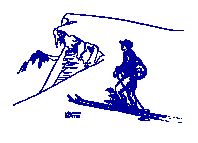
![]()
![]() Skinning up, spirits were raised with an easy ski trip to the pass, where we were rewarded with bright sun, a dry rock for lunch, and glorious views. By 1 PM we were traversing the slope just south of the eastern Hilton Creek Lake. By 2 PM we were camped by this lake, a grand snow kitchen being constructed by the participants. We then played on a favorable slope within a quarter mile of camp, practicing tele-turns and tumbles. As night descended, good cheer was enjoyed at the snow kitchen, while a fiery sunset painted the western skies above Mount Stanford.
Skinning up, spirits were raised with an easy ski trip to the pass, where we were rewarded with bright sun, a dry rock for lunch, and glorious views. By 1 PM we were traversing the slope just south of the eastern Hilton Creek Lake. By 2 PM we were camped by this lake, a grand snow kitchen being constructed by the participants. We then played on a favorable slope within a quarter mile of camp, practicing tele-turns and tumbles. As night descended, good cheer was enjoyed at the snow kitchen, while a fiery sunset painted the western skies above Mount Stanford.
![]()
![]() Sunday morning again dawned bright, clear and sunny. We skied past Lake 10363 and up the chute north of Mount Huntington. Catching our breaths, we were then rewarded with an over 500 foot descent down creamy sunwarmed corn. The ecstasy on the faces of all the participants promised a new crop of Ski Mountaineering aficionados. We returned to camp finding the south side of Lake 10363 easier than the north side we traversed earlier. By 1 PM we were retracing our path over the pass towards Rock Creek, we opted to stay high, traversing the 10360-foot contour until we reached the drainage out of Patricia Lake. Continuous snow validated the choice. Reaching the gully out of Patricia Lake, we descended to the trail, running out of skiable snow below the 10200-foot level. Re-grouping at the intersection of the Hilton Lakes Trail and the steep switchbacks up from the road next to Rock Creek Lodge, we hiked back the mile and a half to the cars, everyone ready for the return trip home by 5 PM.
Sunday morning again dawned bright, clear and sunny. We skied past Lake 10363 and up the chute north of Mount Huntington. Catching our breaths, we were then rewarded with an over 500 foot descent down creamy sunwarmed corn. The ecstasy on the faces of all the participants promised a new crop of Ski Mountaineering aficionados. We returned to camp finding the south side of Lake 10363 easier than the north side we traversed earlier. By 1 PM we were retracing our path over the pass towards Rock Creek, we opted to stay high, traversing the 10360-foot contour until we reached the drainage out of Patricia Lake. Continuous snow validated the choice. Reaching the gully out of Patricia Lake, we descended to the trail, running out of skiable snow below the 10200-foot level. Re-grouping at the intersection of the Hilton Lakes Trail and the steep switchbacks up from the road next to Rock Creek Lodge, we hiked back the mile and a half to the cars, everyone ready for the return trip home by 5 PM.
Thanks to Owen Maloy, Assistant Leader, Pete Yamagata, group photographer, and participants Chris Best, Fred Nicolet, David Alabran, Tani Barbour, Julie Smith-Meek, Scott Meek, Michael Dodson, Paulette Woodward, Gary Landers and Mark Ives. Thanks also to the mountain high pressure system which gave us warm days, calm nights and intense sunburn to every square inch of unprotected flesh.
Keith Martin
Going Light
Grumping by the Assistant Leader
On our recent Hilton Creek trip I noticed that most folks who were newcomers to the SMS were carrying far too much weight. The more junk the equipment industry can sell the more money it makes. Suppliers compete on features, not performance. The results are 7-pound dome tents (not counting the poles) and ridiculously heavy first-aid kits. Maybe the leaders need to carry a little more, but participants need to cut their weight down and go faster to embarrass the leaders. Speed is safety, and therefore lightness, not weight, is safety. One of the purposes of the SMS, stated in the bylaws, is to enhance safety by touring with a group. Every person does not have to be able to camp in ultimate comfort alone, because we don't ski alone.
A spartan reference on going light is the article by Bela and Mimi Vadasz in the Couloir (vol VII No. 2, Dec-Jan '94/'95). They say that a pack for a group multi-day trans-Sierra trip should weigh less than 20 pounds, with food. They suggest some heroic measures (floorless tents, for example), but those who are carrying 50-pound packs for a weekend trip should read this article. I find it hard to get my snow-camping pack under 25 pounds, but a little work (and money) will get it closer. It is essential to share equipment, and the equipment has to work. There is no need for a tool kit, maximum first-aid kit, stove, and tent for every person.
When your pack is light, you will enjoy the skiing more, and be able to crank turns where others must snowplow. Because you will reach the destination sooner, you will get more skiing in, will not be so tired, and will have more fun.
Owen Maloy